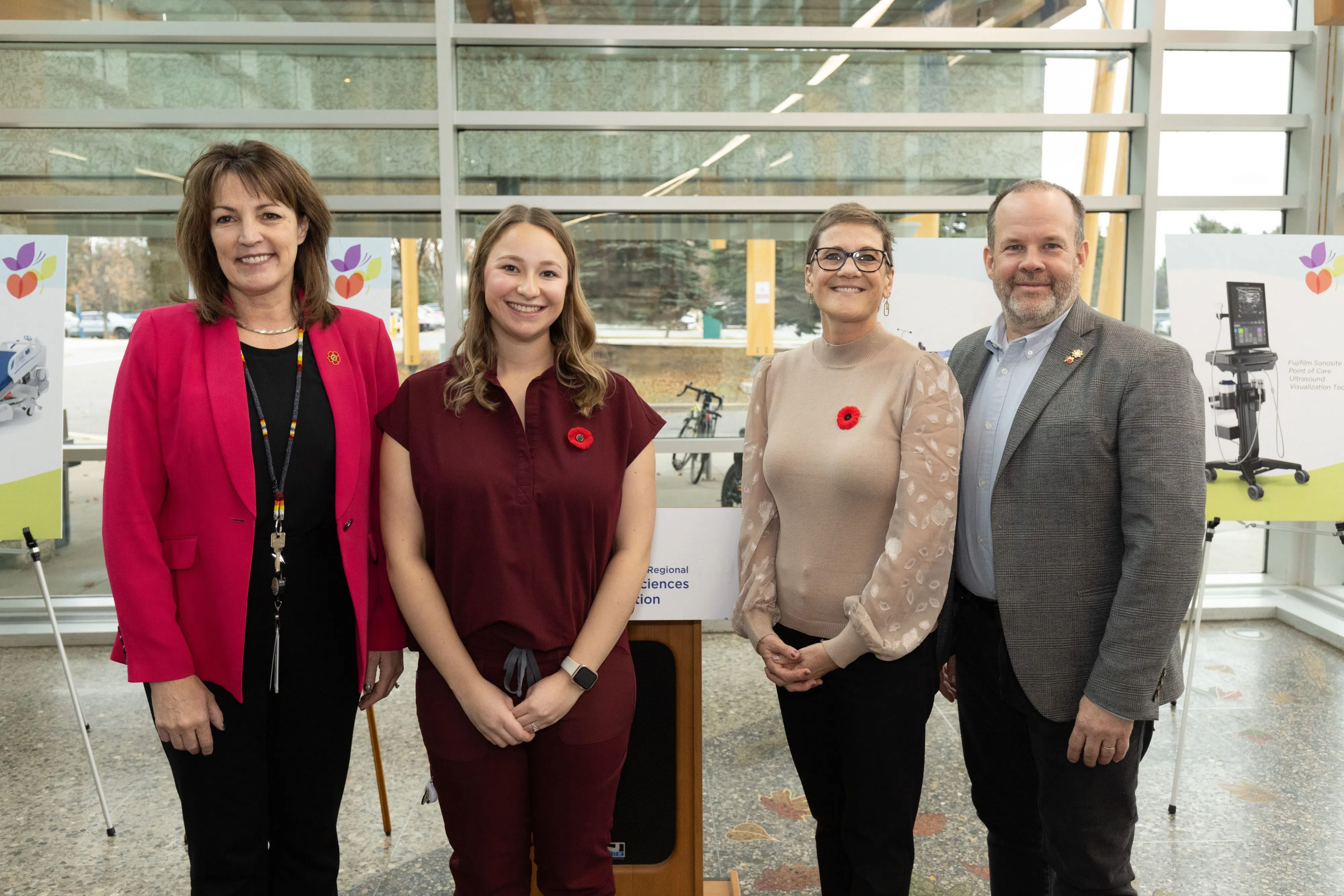
(L-R) Dr. Rhonda Crocker Ellacott, President and CEO Health Sciences Centre and CEO Regional Health Research Institute, Allison Pages, Nuclear Medicine Technologist, Donna Yocom, Foundation Grant Committee Member and Foundation Board Director and Foundation CEO Glenn Craig - Supplied Photo via TBRHSF
The Thunder Bay Regional Health Sciences Foundation is providing $6.6 million in grants to the Thunder Bay Regional Health Sciences Centre, and other hospitals in the region.
The funding is going towards essential equipment.
The foundation raises funds for the hospital through donations, events, and proceeds from the Thunder Bay 50/50.
“The grants established by the Thunder Bay Regional Health Sciences Foundation enable our Hospital to be more responsive to the needs of patients and families in Northwestern Ontario, said the President and CEO of Thunder Bay Regional Health Sciences Centre, Dr. Rhonda Crocker Ellacott. “The incredible generosity of our donors and the continuing work of the Foundation demonstrates our community’s commitment to enhancing care and supporting our Hospital’s vision of Exceptional care for every patient, every time.”
Departments throughout the hospital and other hospitals in the region can apply for grants to acquire new equipment and upgrade essential tools, all of which aim to enhance patient care.
“We understand that the process of evaluating all the grant submissions is no small task,” says Grant Committee Member, Donna Yocom. “Our Committee diligently reviews each request, prioritizing the most pressing needs to ensure the greatest impact on patient care. While we wish we could approve every submission, funding limitations make that challenging.”
Over the past five years, over $27 million in funding has been raised, with the foundation raising a record-setting $7.275 million in 2023.
This year, 36 grants were approved including the following at the Thunder Bay Regional Health Sciences Centre:
- $500,000 to install a new linear accelerator to enhance cancer treatment.
- $500,000 for a new Cardiovascular Imaging System, vital for timely diagnoses.
- $434,034 for trauma care equipment impacting the Emergency Department, Intensive Care Unit, Operating Room, and Labour & Delivery.
- $271,418 for orthopaedic equipment to meet the growing demand for surgeries.
- $238,300 to replace outdated or unsafe equipment in NICU, Paediatrics, Labour & Delivery, and Maternal Newborn.
$1,583,020 is also being directed towards equipment and upgrades in diagnostic imagining including, upgrades to the 5T MRI Scanner which services about 45 per cent of the workload in that department. The upgrade will ensure the machine can maintain consistent care for patients.
The SPECT Camera is also being replaced. The camera is for nuclear medicine.
The health sciences centre is home to the only Nuclear Medicine Department between Winnipeg and Sault Ste. Marie, this upgrade will enhance image quality and efficiency for the 5-10 patients imaged daily during procedures like bone scans and gastric emptying studies, better improving overall patient comfort.
“Our MRI department is extremely busy, serving approximately 16,000 patients each year and performing over 3,500 scans monthly,” says the Manager, of Diagnostic Imaging, Kati Tuomi. “These investments in state-of-the-art equipment and technology will significantly improve our diagnostic services and allow our patients to access tests close to home.”
The grants support not only the Thunder Bay community but also regional areas, as the hospital’s programs reach other hospitals across Northwestern Ontario.
Funding has been approved for equipment in Terrace Bay, Fort Frances, and Kenora.
Riverside Health Care is receiving a chemotherapy chair and gynecological stretcher.
The new chemo chair is replacing an aging unit to enhance patient comfort and safety. The older chair’s difficulty to clean increases infection risks for already-compromised patients.
The new stretcher is specialized and improves comfort and ease during OB/GYN examinations, particularly for patients undergoing chemotherapy. This stretcher can also serve as a general stretcher, enhancing overall utility.
In Kenora, the Lake of the Woods District Hospital is getting a replacement for an older mammography unit.
The hospital is a satellite site of Regional Cancer Care and performs over 1,700 mammographies annually, including for 10 remote First Nations.
The current mammography unit is at the end of its life, prone to breakdowns requiring week-long repairs.
The new unit is capable of providing enhanced imaging standards, including contrast-enhanced breast imaging and tomosynthesis (3D mammography).
